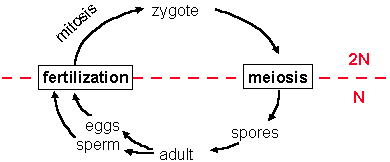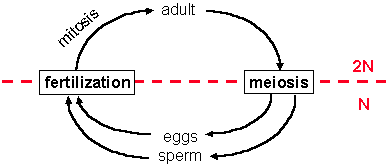
Introduction to Life Cycles
The diagram below shows a typical animal life cycle.

1. Draw a life cycle that has haploid adults. To do this, first, draw a dotted line to separate haploid stages from diploid stages.
2. Next, label the area above the dotted line "diploid" (or "2N") and the area below the line "haploid" (or "N").
3. Add the words "fertilization" and "meiosis" as shown in the diagram above.
In order to get from above the line to below the line (from diploid to haploid), a cell must undergo meiosis. In order to get from below the line to above the line (from haploid to diploid) fertilization must occur.
4. After this is done, add the following terms:
adult, sperm, eggs, meiosis, mitosis, fertilization, zygote, 2N (diploid), N (haploid), spore (Spores are haploid cells that are capable of growing into haploid adults. They may be resistant to environmental extremes and thus allow overwinter survival or survival during dry periods. They may also be a mechanism to allow dispersal of the species. For example, windborne spores may be carried for many miles before they are deposited.)
5. Draw a life cycle that has diploid adults.
6. Draw a life cycle that alternates haploid and diploid adults.
In general, 3 types of life cycles exist:
a) those with a haploid adult

b) those with a diploid adult

c) and those that alternate between a haploid generation and a diploid generation
